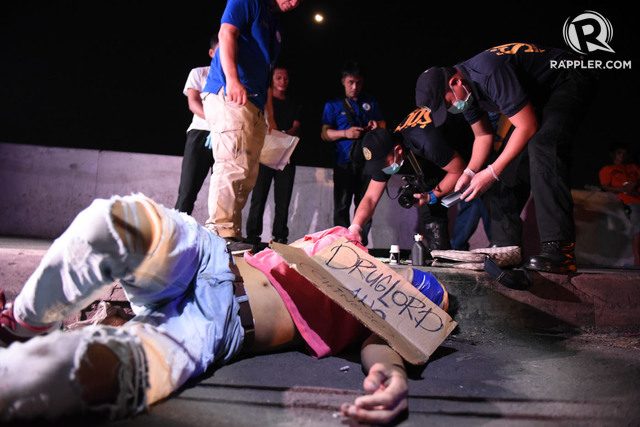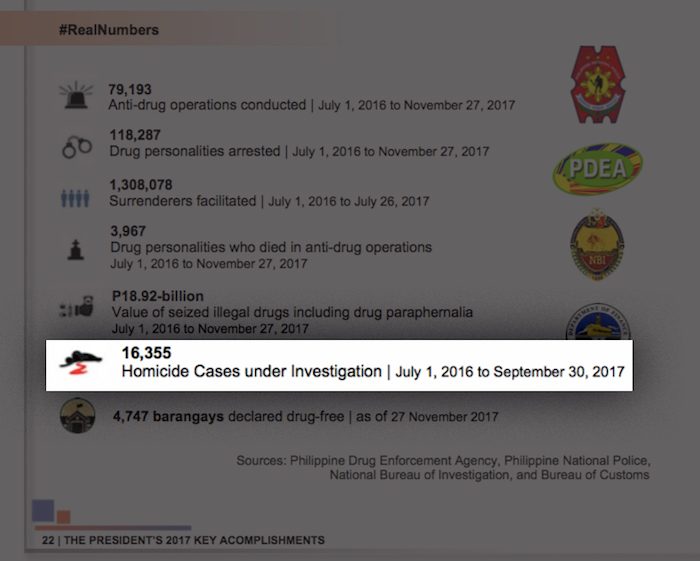SUMMARY
This is AI generated summarization, which may have errors. For context, always refer to the full article.

MANILA, Philippines – Ever since President Rodrigo Duterte assumed office almost two years ago, 33 people have been killed daily nationwide.
This is shown by Philippine National Police (PNP) documents obtained by Rappler. In about two years – from July 1, 2016, up to June 11, 2018 – police have recorded 23,518 Homicide Cases Under Investigation (HCUI), equivalent to an average of 33 people killed a day.
HCUIs are murder and homicide cases combined, excluding killings by cops in police operations. Riding-in-tandem killings, being homicides and murders too, are included in this tally.
From July 1, 2016 to May 15, 2018, the government’s counting initiative #RealNumbersPH has tallied 4,279 suspects killed in anti-illegal drug operations, or an average of 6 a day.
The 4,279 are not included in HCUIs as they are presumed to have been carried out by cops in the line of duty.
The killings come as the Duterte administration continues to pursue an unrelenting campaign against drug suspects and criminals, with the President going on record on multiple occasions, encouraging law enforcers and Filipinos to harm and even kill delinquents.
A quick look at PNP data on Duterte’s first year in office shows that the campaign has resulted in a drop in all index crimes (or crimes against persons and property) – but not the killings.
All drug-related?
Not all of the 23,518 homicide cases under investigation fall under the government’s unrelenting anti-illegal drug campaign, the PNP claims.
As the PNP has repeatedly pointed out, the killings were not executed by state forces, but civilians. There are reports, however, accusing cops of going rogue and carrying out the killings themselves, if not supervising them.
The 23,518, according to the PNP, can also be further broken down into drug-related, non-drug related, and cases with motives still undetermined.
Rappler inputs the latest update on the figures in the graph below:
Of all the homicide cases under investigation, 11.34% were found to be drug-related, 45.55% non-drug-related, and 43.17% calling for a better scrutiny of motives.
According to PNP Directorate for Investigation and Detective Management-Case Monitoring Division (DIDM-CMD) chief Senior Superintendent Ferdinand Bartolome, killings are classified by the PNP as drug-related if the victim or the killer are drug suspects, or if the motive for the killing is drug-related.
If the case does not have anything to do with drugs, it is classified as non-drug-related. Should further investigation reveal that a non-drug-related case turns out to have a drug angle later, the case’s count is transferred to drug-related cases.
In a majority of drug-related cases, Bartolome told Rappler, the killings were done to “prevent the victim from divulging detrimental information to the drug trade.”
On the other hand, the majority of the non-drug-related HCUIs were carried out due to a personal grudge, coming from “heated arguments and misunderstanding, personal gain, hatred, revenge, land dispute, love triangle, family feud, atrocities, lust, work-related, road rage, and others.”
Remember: EJK, DUI, HCUI, DPO
It took long for the PNP to settle with the term “HCUI” or homicide cases under investigation.
It can be traced all the way to the early months of the Duterte administration in 2016, when the number of vigilante-style killings soared with almost nightly riding-in-tandem shootings and dumping of corpses in canals and streets. Many bodies bore signs of torture before their final breaths, and were left with cartons labeling them as drug suspects.
These were matched by the rising numbers of killings in police operations because of suspects allegedly fighting back (“nanlaban“).
Given these circumstances, human rights advocates and critics alleged the existence of extrajudicial killings or EJKs, referring to those killed in the streets and those killed by cops during anti-drug operations. The term easily became part of the public lingo, inviting scrutiny of the PNP.
In response, the government created the term deaths under investigation (DUI), intended to distinguish killings that were committed outside the government’s campaign from those that were part of police operations. It has the same definition as today’s HCUI: murder and homicide cases combined, excluding killings by cops in police operations.
The PNP regularly released the number of DUIs, just to show that they were keeping a record of the deaths and that most were not drug-related.
The killings that happened under police operations, on the other hand, were said to involve suspects who “died during police operations” or simply “DPO”. They died because they allegedly resisted searches or arrests. While all were presumed to be regular by the PNP, allegations persist that DPOs are the same as EJKs.
Reports have accused cops of mercilessly gunning down defenseless drug suspects then planting evidence to make it appear that the accused put up a fight. Things came to a head with the explosive case of 17-year-old Kian delos Santos.
Based on Rappler’s timeline, the PNP tried to discreetly introduce the term “HCUI” in March 2017.
Why the change? According to the PNP’s Bartolome, they simply didn’t want to confuse the international community.
“Because abroad, DUI meant driving under the influence [of alcohol],” he told Rappler. Without a formal announcement about the shift, some media outlets continue to use the popular term DUI.
Whatever label the government uses to distinguish deaths, however, the killings continue to rise.
Troubled regions
Below is a chart showing the total number of killings per region and how efficient they are at solving them:
The country’s two most developed regions, Metro Manila and Calabarzon, are where almost a third of the killings happen. Metro Manila accounts for 18.06% while Calabarzon accounts for 13.25% of all HCUIs.
The northern Cordillera Administrative Region (CAR) and Mimaropa, meanwhile, have recorded the least HCUIs with 271 and 432, respectively.
Of the 23,518 killings, 12,470 have either been cleared or solved. This gives the PNP a crime solution efficiency rate of 53.02% for HCUIs.
HCUIs: An accomplishment?
Are killings something to be proud of?
When Malacañang recorded HCUIs as an accomplishment of the Duterte administration’s anti-drug campaign in its 2017 yearend report, it raised a lot of brows.
The report was prepared by the Presidential Communications Operations Office (PCOO), which also manages the government’s #RealNumbersPH initiative.
The HCUI numbers were placed in the summary, despite the PNP already clarifying back in August 2016 that not all of them can be linked to the government’s anti-illegal drugs campaign.
Shown a #RealNumbersPH card which included HCUIs as achievements, PNP DIDM chief Director Elmo Sarona said the PNP had never considered the numbers as accomplishments.

The two-star general surmised that the number was added to show that the government was being transparent, and is exhausting all efforts to lower the number.
But, the report did not break down the number into how many of the cases were already solved. It just announced thousands of deaths, complete with an icon of a dead man with blood streaming from his body. (READ: A look at the state of crime, drugs in the Philippines)
Is it a communications mishap? The PNP doesn’t think so, given that their officials meet with PCOO officers monthly to update the numbers. Rappler has reached out to PCOO Assistant Secretary Queenie Rodulfo for the Palace’s reason for including HCUIs in its accomplishment report.
In stopping the numbers from rising, the PNP continues to move with the mentality that bringing down illegal drugs will also bring down crime. As records have already shown, the strategy appears to be working for all crimes, except for the gravest one: killings.
The PNP now faces the challenge of bringing down the number of killings, an achievement that it has yet to be proud of. – Rappler.com
Graphic by Nico Villarete. Photos by Alecs Ongcal, Rambo Talabong/Rappler; AFP photo; Malacañang photo
Add a comment
How does this make you feel?
There are no comments yet. Add your comment to start the conversation.